

|
Transhumance in Vivarais from Saint-Ambroix and Les Vans towards the heights of Tanargue via Montselgues, Loubaresse and Le Bez in Ardèche (Auvergne-Rhone-Alpes). |

 Chambons has to regulate the passage of the transhumants through the forest of Bauzon which belongs to him. A few rare documents from the 15th century show us the peasants of the lowlands summering their sheep on the high plateaus. From the 16th century onwards, the documents multiply to affirm the considerable role of the peasant transhumance: the flocks of the parishes of the low Vivarais plateaus (Chandolas, Saint-Alban-sous-Sampzon, etc…) or of the lower Cévennes (Joannas, Lablachère, etc…) go up in summer in the region of Saint-Etienne-de-Lugdarès; those of Jaujac, in the middle of the Cévennes, go to summer near La Chapelle-Grailhouse. These movements increased in the modern era, on the one hand because the monastic flocks had to be seriously frayed after the Hundred Years’ War which brought about the decline of the monasteries, completed by the wars of religion, so that in the 18th century the abbey of Mazan had only 800 sheep, and on the other hand because the monasteries renounced direct exploitation: in 1781, Mazan welcomed foreign flocks for a fee.
Chambons has to regulate the passage of the transhumants through the forest of Bauzon which belongs to him. A few rare documents from the 15th century show us the peasants of the lowlands summering their sheep on the high plateaus. From the 16th century onwards, the documents multiply to affirm the considerable role of the peasant transhumance: the flocks of the parishes of the low Vivarais plateaus (Chandolas, Saint-Alban-sous-Sampzon, etc…) or of the lower Cévennes (Joannas, Lablachère, etc…) go up in summer in the region of Saint-Etienne-de-Lugdarès; those of Jaujac, in the middle of the Cévennes, go to summer near La Chapelle-Grailhouse. These movements increased in the modern era, on the one hand because the monastic flocks had to be seriously frayed after the Hundred Years’ War which brought about the decline of the monasteries, completed by the wars of religion, so that in the 18th century the abbey of Mazan had only 800 sheep, and on the other hand because the monasteries renounced direct exploitation: in 1781, Mazan welcomed foreign flocks for a fee.
At the beginning of the 19th century, the foreign flocks came in such quantity on the high plateaus that they worried the mountaineers: under the Empire, in Sagnes as in Cros-de-Géorand, the mayors complained about these foreign flocks too numerous that devoured all the grass and even the brooms indispensable for the covering of the houses. It was at this time that flocks from the Gard began to arrive, wintering between Alès and Nîmes and even from the Vaucluse (Monteux) which reinforced the classic Vivarais transhumance. The first part of the 19th century, the peak of rural population, was also, without a doubt, the peak of sheep transhumance, which, every summer, pushed towards the high plateaus the largest part of the animals of the Cévennes valleys of the Ardèche, the Lignon, the Beaume, the Drobie and the limestone plateaus more to the east, in addition to the large contingents from the Gard and the Vaucluse. Thus, the small commune of Loubaresse, on its 900 hectares, welcomed in 1840, 1,700 foreign sheep, which were added to the 500 natives for the 3 to 4 months of the beautiful season. It is difficult, however, to know the exact number of animals summered at that time: some texts indicate more than 100,000 heads, and this is not impossible, since the moors could accommodate 3 to 4 heads per hectare. Moreover, it is necessary to add 40,000 native sheep.
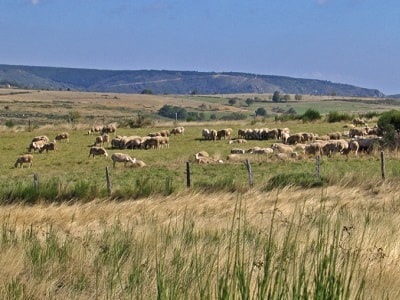 All the high plateaus were more or less concerned. On the plateau of Saint-Agrève, already very northern, only the commune of Devesset was affected, because of the old possessions of the Hospitallers: the tradition was preserved after the Revolution, since in 1837, Devesset welcomed more than 3,000 sheep, coming mostly from Provence. The surroundings of Mézenc, from Mézilhac to Estables and to the nascent Loire, also welcomed many, as indicated by documents from the 18th century, and they came from far away, from the Gard and the Vaucluse. However, it is further south, between the Loire and the Allier, that at all times, around the heights of Tanargue, lies the summer kingdom of the transhumants. There, indeed, the vast grassy moors suitable for sheep undulate, and most of which remained property of the hamlets, easy to rent to foreign shepherds. The mountain communities lived mainly from the cultivation of rye, associated with a modest breeding of horned and woolen animals, but the impossibility of feeding a large herd in winter, for lack of mowing meadows, forbade to own large woolen numbers, capable of taking advantage of the overabundance of summer grass. However, the surplus sheep were all the more appreciated as they could provide a fertilizer essential to the rye fields, following carefully established modalities.
All the high plateaus were more or less concerned. On the plateau of Saint-Agrève, already very northern, only the commune of Devesset was affected, because of the old possessions of the Hospitallers: the tradition was preserved after the Revolution, since in 1837, Devesset welcomed more than 3,000 sheep, coming mostly from Provence. The surroundings of Mézenc, from Mézilhac to Estables and to the nascent Loire, also welcomed many, as indicated by documents from the 18th century, and they came from far away, from the Gard and the Vaucluse. However, it is further south, between the Loire and the Allier, that at all times, around the heights of Tanargue, lies the summer kingdom of the transhumants. There, indeed, the vast grassy moors suitable for sheep undulate, and most of which remained property of the hamlets, easy to rent to foreign shepherds. The mountain communities lived mainly from the cultivation of rye, associated with a modest breeding of horned and woolen animals, but the impossibility of feeding a large herd in winter, for lack of mowing meadows, forbade to own large woolen numbers, capable of taking advantage of the overabundance of summer grass. However, the surplus sheep were all the more appreciated as they could provide a fertilizer essential to the rye fields, following carefully established modalities.
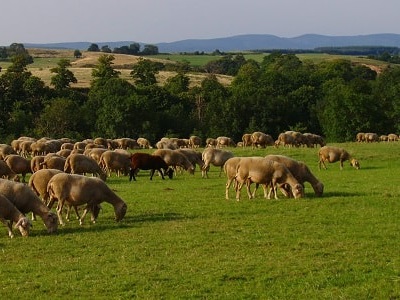 It is in the 19th century, because of the abundance of documentation, that one can best know the life of the transhumants and their insertion into the economic and social system of the high Vivarais plateaus, but the situation analyzed must have differed little from the previous centuries, as this mode of breeding is based on immemorial customs. Simple difference, formal by the way: the flocks all belong to people from the lowlands, whereas formerly immense squads were the property of the monks of the highlands. The numbers are now small: 200 to 500 heads per flock, and they belong to peasants, not specialists. Two ways of proceeding. The first consists of grouping the animals of a village or even several to form the “parjade” or transhumance flock, under the guidance of a shepherd designated by the community: this is the system of the common shepherd applied to summering, which is the rule in the cantons of Joyeuse and Valgorge. In the second case, it is a summering contractor who takes care, for a fee, of taking away the animals entrusted to him: thus, in the canton of Thueyts, the animals are marked at the start and the shepherd receives from each one a price agreed for the summer and it was already the rule in the 17th century.
It is in the 19th century, because of the abundance of documentation, that one can best know the life of the transhumants and their insertion into the economic and social system of the high Vivarais plateaus, but the situation analyzed must have differed little from the previous centuries, as this mode of breeding is based on immemorial customs. Simple difference, formal by the way: the flocks all belong to people from the lowlands, whereas formerly immense squads were the property of the monks of the highlands. The numbers are now small: 200 to 500 heads per flock, and they belong to peasants, not specialists. Two ways of proceeding. The first consists of grouping the animals of a village or even several to form the “parjade” or transhumance flock, under the guidance of a shepherd designated by the community: this is the system of the common shepherd applied to summering, which is the rule in the cantons of Joyeuse and Valgorge. In the second case, it is a summering contractor who takes care, for a fee, of taking away the animals entrusted to him: thus, in the canton of Thueyts, the animals are marked at the start and the shepherd receives from each one a price agreed for the summer and it was already the rule in the 17th century.
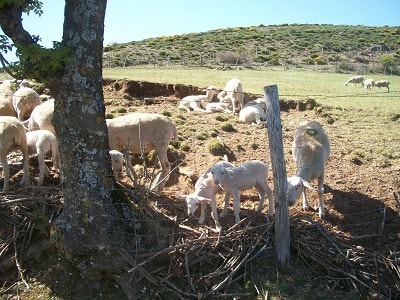 The departure took place in the first fortnight of June and the return in the first fortnight of September, so that the stay in the mountains lasted about a hundred days. The journeys were made along the immemorial tracks, the famous drailles, wide paths of 12 to 20 m wide, true corridors for flocks. There were three main ones: the one that led from Saint-Ambroix and Les Vans to the heights of Tanargue by Montselgues, Loubaresse, Le Bez; the one that borrowed the valley of the Ardèche and the col de la Chavade; and finally the one that, starting from the low Vivarais plateaus, climbed to Saint-Laurent-en-Coiron, the col de l’Escrinet, and continued to the Gerbier and the Mézenc. It was this path that in 1337 the sheep of Mazan took from the barns of Berg to Montlaur, which required an agreement with the lord of Montlaur to settle the right of pulverization. And, in 1905, one still saw 6,000 sheep pass in 28 parjades, a fine example of longevity.
The departure took place in the first fortnight of June and the return in the first fortnight of September, so that the stay in the mountains lasted about a hundred days. The journeys were made along the immemorial tracks, the famous drailles, wide paths of 12 to 20 m wide, true corridors for flocks. There were three main ones: the one that led from Saint-Ambroix and Les Vans to the heights of Tanargue by Montselgues, Loubaresse, Le Bez; the one that borrowed the valley of the Ardèche and the col de la Chavade; and finally the one that, starting from the low Vivarais plateaus, climbed to Saint-Laurent-en-Coiron, the col de l’Escrinet, and continued to the Gerbier and the Mézenc. It was this path that in 1337 the sheep of Mazan took from the barns of Berg to Montlaur, which required an agreement with the lord of Montlaur to settle the right of pulverization. And, in 1905, one still saw 6,000 sheep pass in 28 parjades, a fine example of longevity.
It was, without a doubt, a colorful and noisy spectacle that took place in June and September, along these ancient roads. But it has been often described. We will only say that the ram, leader of the flock, wore, embedded in his collar, fetish stones intended to protect the animals from diseases and evil spells, for this “peyrassou” appears as the testimony of the antiquity of the pastoral customs linked to transhumance. In any case, life in the mountains obeyed a number of precise rules, often codified in contracts, concerning the use of pastures. Except, indeed, the case of the monastic flocks, the shepherds owned nothing on the heights. It was therefore necessary to rent the land. Towards the Tanargue, in the middle of the 19th century, the rental price of the commons was established on the basis of 5 francs per hectare for 3 to 4 sheep per hectare. In some cases, the fee could be lower. Thus, on the domain of Villevieille, an old farm of the Carthusians near the Mézenc, one received 1,000 to 1,500 sheep for three months for a few pennies only per head, because these sheep grazed the rejects of the horned animals and ensured the manuring of the meadows. Similarly, in 1862, all the common grasslands of La Chapelle Grailhouse were leased to a shepherd from Jaujac who brought 400 ewes there for only the manuring of the lands of the individuals and the guarding of 100 local woolen animals. On the other hand, the inhabitants fed the shepherd and his dogs.
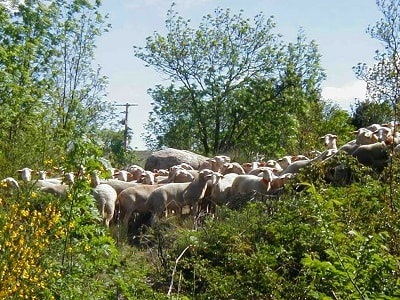 The most remarkable custom was that of the nights of manuring, attested as early as the 13th century, and still in force in the 20th, as shown by a trial of 1923 opposing the inhabitants of the hamlet of Masméjan (commune of Saint-Etienne de Lugdarès) on the subject of the distribution of the product of these nights of manuring, which resulted from an act of the abbey of Chambons of May 17, 1457. The sheep had to sleep at night in parks on the fallow fields of the individuals, who paid for this purpose a fee to the shepherd, spending the night in a summary hut, called the “chabotte”. Thus there existed a close symbiosis between the foreign pastoral life and the mountain agriculture.
The most remarkable custom was that of the nights of manuring, attested as early as the 13th century, and still in force in the 20th, as shown by a trial of 1923 opposing the inhabitants of the hamlet of Masméjan (commune of Saint-Etienne de Lugdarès) on the subject of the distribution of the product of these nights of manuring, which resulted from an act of the abbey of Chambons of May 17, 1457. The sheep had to sleep at night in parks on the fallow fields of the individuals, who paid for this purpose a fee to the shepherd, spending the night in a summary hut, called the “chabotte”. Thus there existed a close symbiosis between the foreign pastoral life and the mountain agriculture.
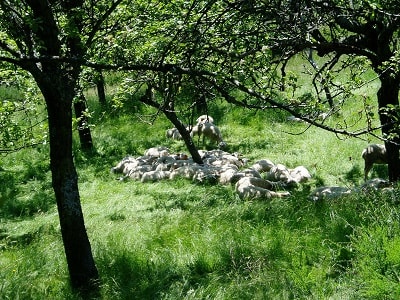 Transhumance declined after 1870, as economic conditions changed. In Devesset, the sale of the commons harmed the transhumants who, from more than 3,000 at the end of the 18th century, dwindled to 500-600 a century later, to disappear before 1914. In Loubaresse, the reforestation by the Water and Forests, after 1877, dealt a fatal blow to transhumance. Especially the cultivation of rye is in great decline and the manure by foreign sheep is no longer of interest. In the lowlands, for various reasons, the flocks of sheep disappear. At the beginning of the 20th century, transhumance had certainly decreased by half, hardly carrying more than 40,000 to 50,000 heads. Around 1930, there were hardly more than 20,000, mainly concentrated around Tanargue. Twenty years later, only a dozen flocks from the Gard came, a little more than 3,000 sheep. Since then, transhumance on the high Vivarais plateaus has completely disappeared. From this overview of 7 centuries of transhumance on this eastern border of the Massif Central, some conclusions can be drawn.
Transhumance declined after 1870, as economic conditions changed. In Devesset, the sale of the commons harmed the transhumants who, from more than 3,000 at the end of the 18th century, dwindled to 500-600 a century later, to disappear before 1914. In Loubaresse, the reforestation by the Water and Forests, after 1877, dealt a fatal blow to transhumance. Especially the cultivation of rye is in great decline and the manure by foreign sheep is no longer of interest. In the lowlands, for various reasons, the flocks of sheep disappear. At the beginning of the 20th century, transhumance had certainly decreased by half, hardly carrying more than 40,000 to 50,000 heads. Around 1930, there were hardly more than 20,000, mainly concentrated around Tanargue. Twenty years later, only a dozen flocks from the Gard came, a little more than 3,000 sheep. Since then, transhumance on the high Vivarais plateaus has completely disappeared. From this overview of 7 centuries of transhumance on this eastern border of the Massif Central, some conclusions can be drawn.
Transhumance is linked on the one hand to the agricultural predominance of the Vivarais mountain (or incidentally to cattle breeding around the Mézenc) and on the other hand to the abundance of moors, which the peasants could hardly take advantage of, not knowing what to do with their sheep in winter. Transhumance provided them with cheap fertilizer. This is a phenomenon peculiar to the Massif Central and not found in the mountains rich in alpine pastures like the Alps. It reached its extreme point here to the north, at Devesset, because, because of the Rhone opening, the Mediterranean conditions rise to the north, up to the Coiron, and the rise of the Massif Central, here maximum, offers, at a very short distance, high altitude pastures. In the Middle Ages, the monasteries established on the heights organized a downward transhumance with a short radius that would last, diminishing, until the Revolution. But it rubs shoulders with an upward transhumance of small peasant flocks. The latter takes over from the beginning of the Modern Times, due both to the monastic decadence and to the demographic growth that accelerates in the 18th century.
Old romantic Hotel, L'Etoile Guest-House is a mountain retreat in the South of France. With a beautiful park along the Allier River, L'Etoile Guesthouse is located in La Bastide-Puylaurent between Lozere, Ardeche and Cevennes. Hiking trails: GR®70 Stevenson trail, GR®700 Regordane way (St Gilles trail), GR®7, GR®72, GR®470 Allier river trail. Hiking loops: Cevenol, Ardechoise, Margeride. The right place to relax.
Copyright©gr-infos.com